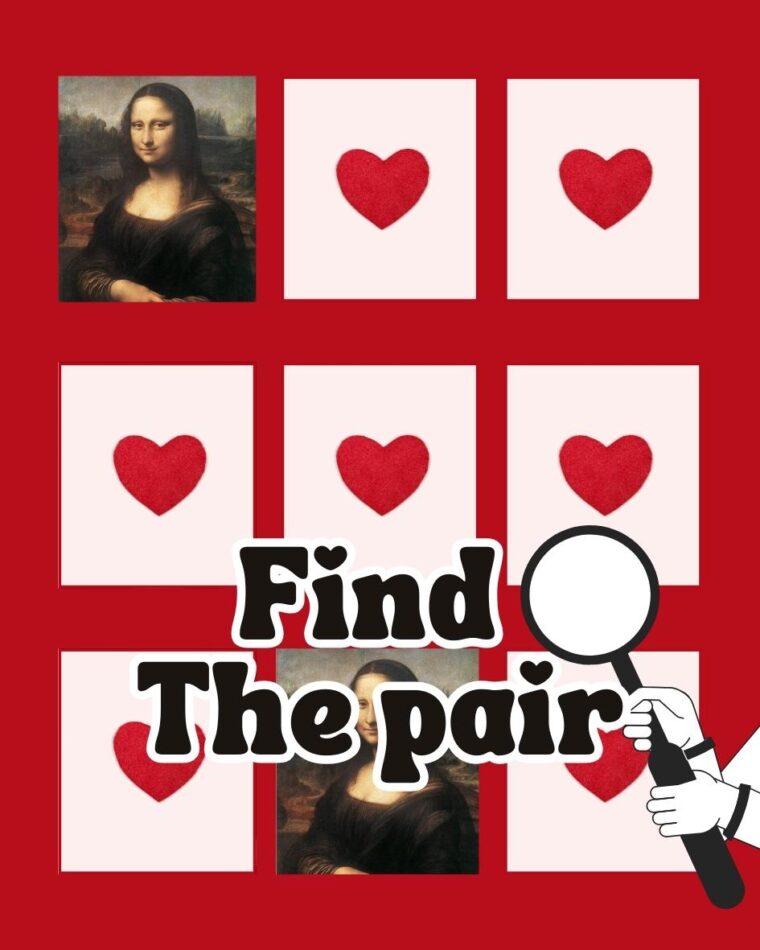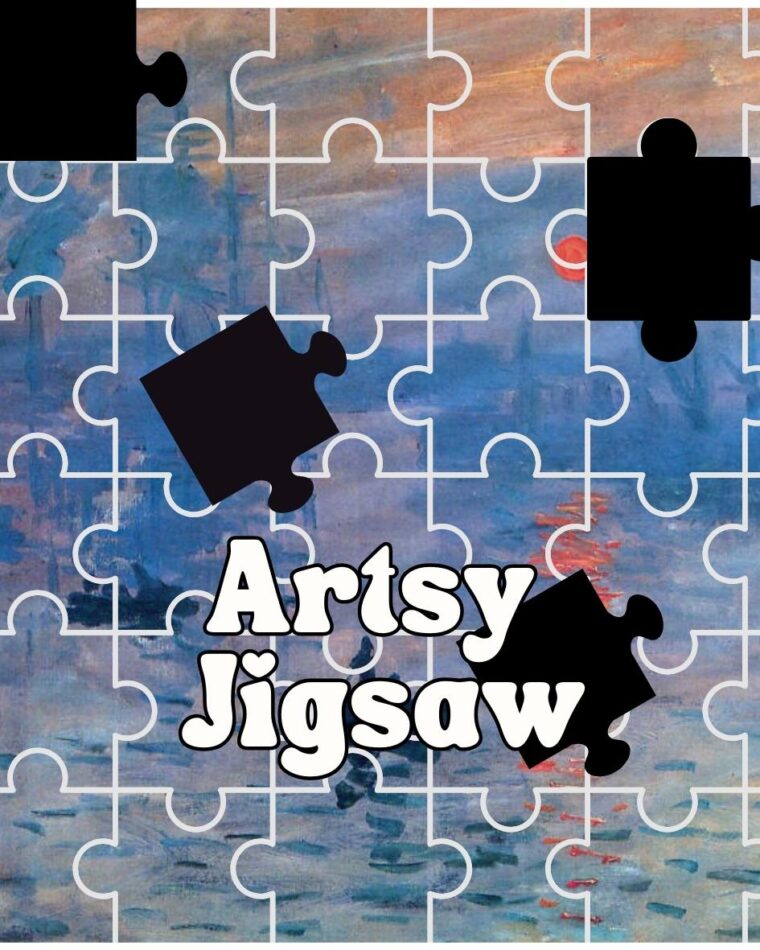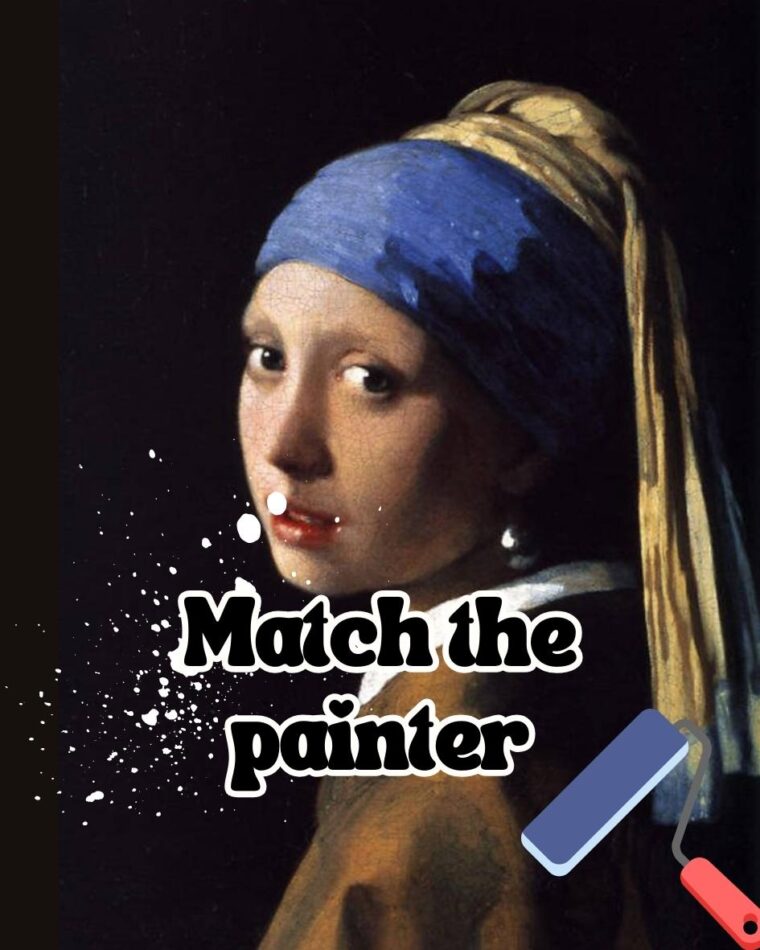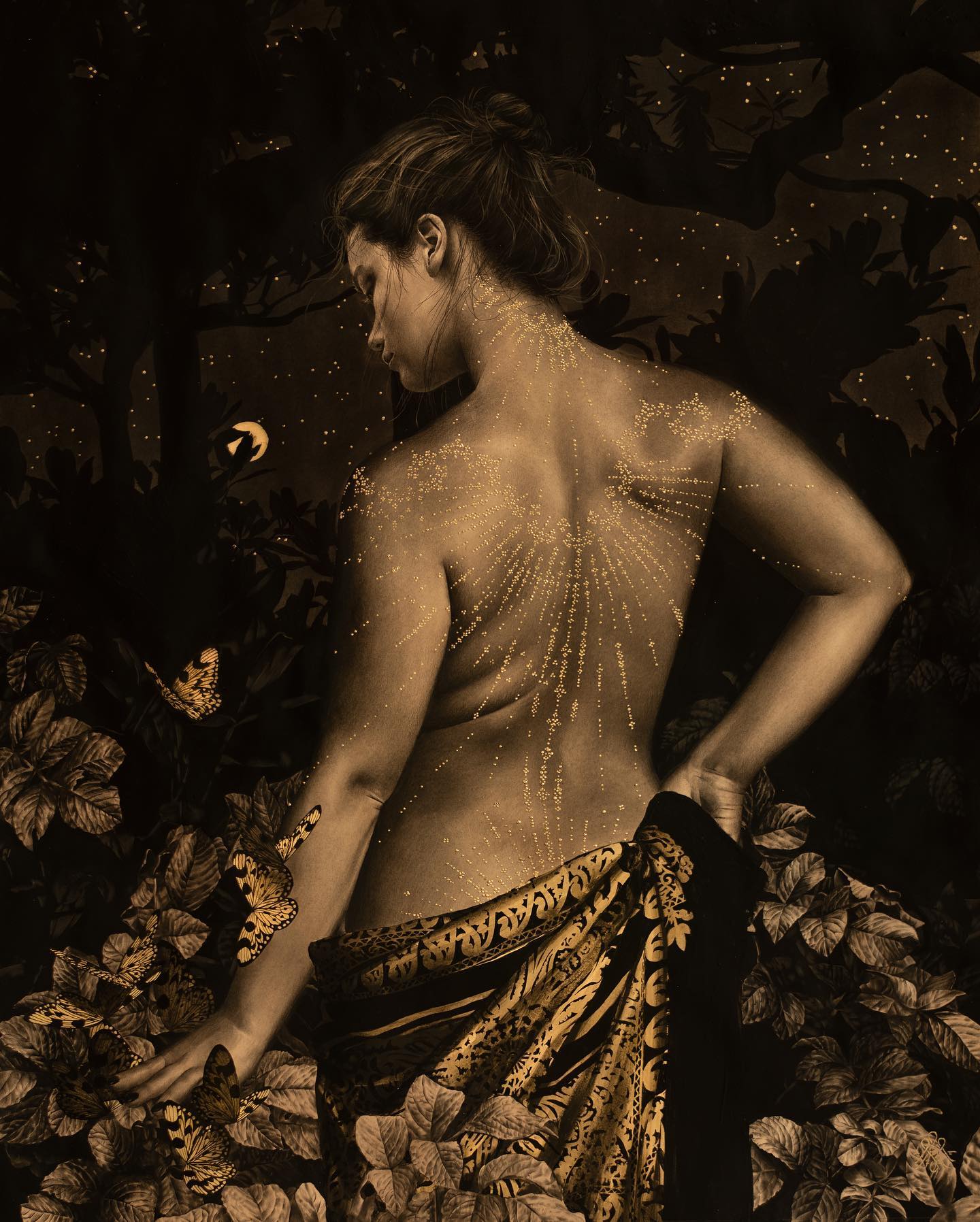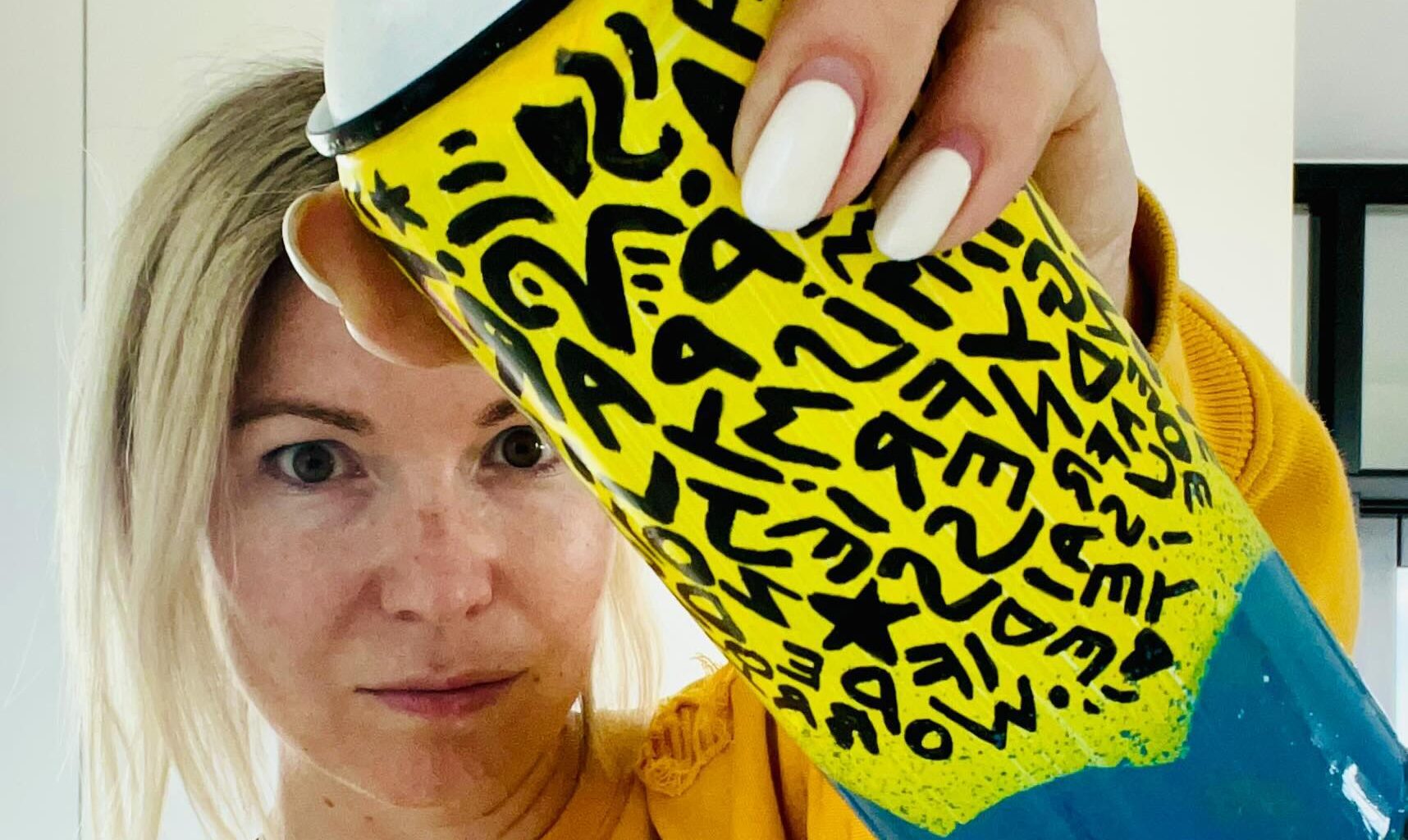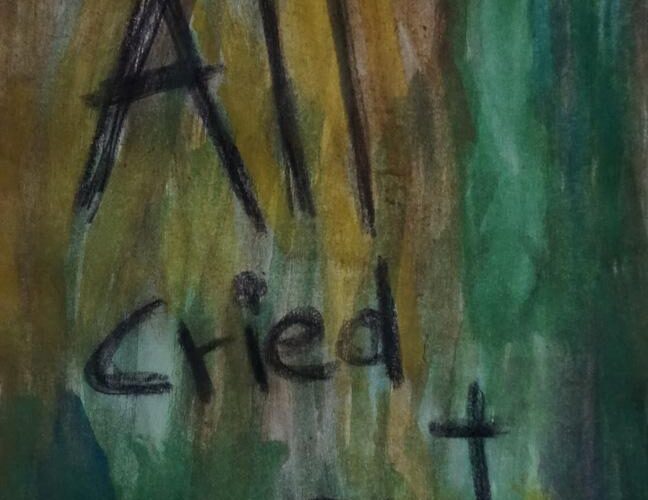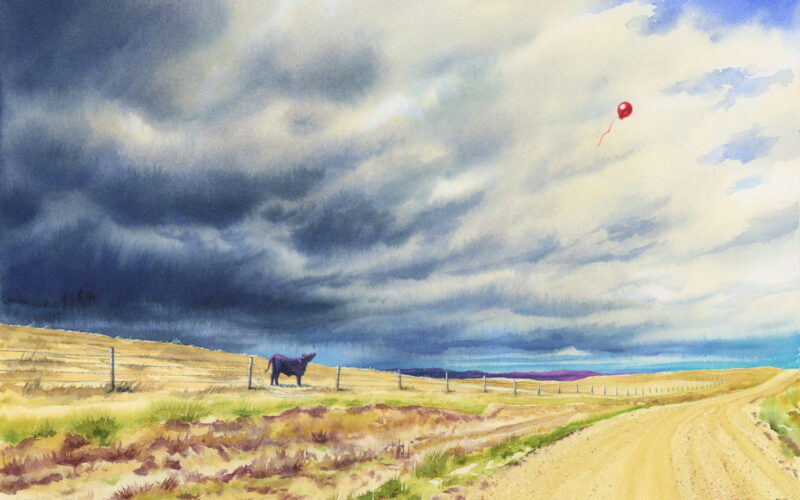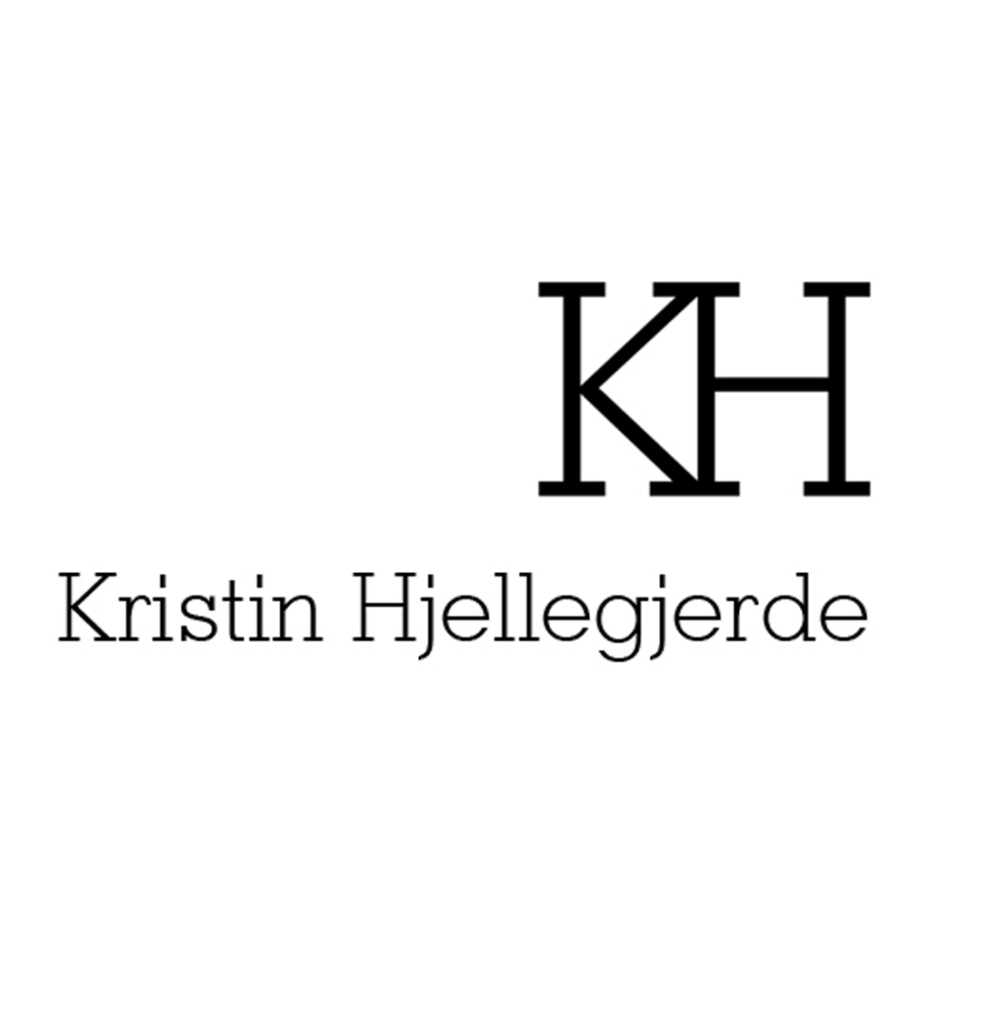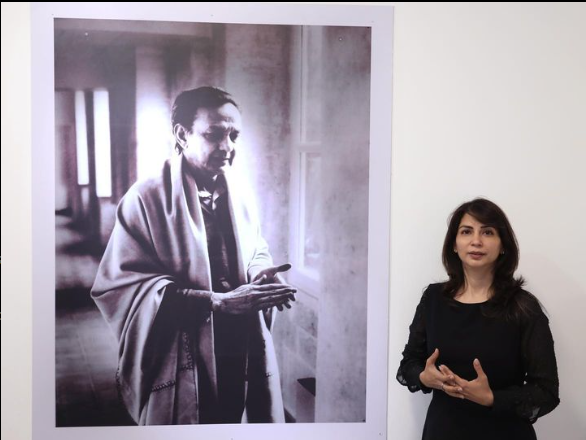

Watch & Listen to this podcast Episode.
Welcome to our episode with artists Kat Vandal and Eileen Hall. In this episode, we talk about how childhood creativity and colors affect art.
In discussion with our host Charuka Arora, Kat Vandal and Eileen Hall share how going back to their childhood creativity has helped their art. They discuss how embracing childlike wonder can bring fresh ideas and inspiration. They share personal stories and give practical advice on how to reconnect with your inner child and enjoy the playful side of making art.
They also talk about the powerful role of color in art. Kat and Eileen explain how different colors make us feel different emotions and how they use this in their work. They give tips on color theory, the psychological effects of color, and how artists can use color to tell emotional stories in their art.
This episode helps listeners understand how childhood experiences and the use of color can deeply influence an artist’s work. Whether you’re a new artist or have been creating for years, you’ll find valuable tips and inspiration to explore new aspects of your art.
Join us to learn how embracing your inner child and using the emotional power of colors can change your art journey.
| Chapter | Timestamp | Summary |
|---|---|---|
| Introduction | 00:00 – 03:00 | Introduction of the podcast and the guests, Kat Vandal and Eileen Hall. Overview of the topics to be discussed. |
| Childhood Inspirations | 03:01 – 15:00 | Discussion on how childhood experiences and inspirations influence their |
00:01.36
Charuka Arora
Hey, you guys. Welcome back to the Arts to Hearts podcast. I’m very excited to have two amazing guests today. I have Kat and Eileen from our recent project of Color’s Book and an Exhibit. And I’m very excited to bring them both on the podcast so that we can learn more about them, who they are, and what they do. Welcome to the podcast, Kat and Eileen.
00:21.87
Kat Vandal
Thank you so much.
00:22.23
Eileen Hall
hi Hello.
00:26.10
Charuka Arora
Yes, Eileen, hi.
00:29.99
Charuka Arora
Thank you, guys. Thank you so much for coming. how I’m very excited. i want to you know I want people to know more about you. You’re also recently published artist from you know our project. And before we go in there and and you know get to know who you are, the work you do, how about we start with an introduction? Eileen, do you want to start?
00:51.84
Eileen Hall
and Sure. ah My name is Eileen Hall and I am an Ecuadorian and Scottish artist and creative director.
00:57.06
Kat Vandal
Okay.
01:00.12
Eileen Hall
um My work centres a lot around nature connection, um music, consciousness and altered states. Actually, it’s inspired by meditation a lot. And um I really believe in art being a force for good in the world. So I use a lot of it to kind of talk about things like protecting the Amazon, which is what I’m connected to, and um and also feeding into spaces of of, like I said, music and meditation.
01:30.70
Charuka Arora
Wonderful. Sounds very interesting. I’m going to ask you questions on that. ah But let’s go to Kat first. Hi, Kat.
01:38.42
Kat Vandal
ah Hi, so my name is Kat, Kat Vandal. I’m a French artist based in London. I’ve been living in London for 17 years. I’m a mom of a boy who’s eight years old, who I would say inspires me a lot.
01:50.59
Charuka Arora
Oh, wow. You don’t look like one.
01:53.54
Kat Vandal
Thank you. But yeah, it’s my true inspiration. So we do we do lots of arts together. It’s very creative and…
02:00.12
Charuka Arora
That’s how you turn trash to treasures.
02:03.39
Kat Vandal
Sorry.
02:04.51
Charuka Arora
That’s how you turn trash to treasures. I saw one of your posts.
02:08.76
Kat Vandal
Yes, yes.
02:09.19
Charuka Arora
ah you can
02:11.15
Kat Vandal
we’ We’ve done that a lot since he was since he was very little. We’ve we’ve always you know loved to create toys with cardboard or anything, you know with plastic. So we’ve done lots of upcycling together.
02:20.03
Charuka Arora
Yeah.
02:22.04
Kat Vandal
And for him, you know seeing the transformation from trash to treasure, um you know I just love to see you know the the stars in his eyes.
02:26.81
Charuka Arora
yeah
02:30.55
Kat Vandal
So i I’ve always loved ah upcycling and reusing objects, everyday objects and transforming them into art. um and especially now I’m much more focused on using toys or any kind of childhood favorites um just to to to create you know colorful works of art and kind of invite people to rediscover the magic of childhood. So yeah, my art is really inspired by the children, by childhood, but also there is a whole sustainable part of it when I just love to show how you know anything can be really reused and
03:07.79
Kat Vandal
have a sick and life.
03:10.63
Charuka Arora
I loved that, but also, you know, when I was looking, when I was looking at your work, I also did feel, um you know, like it also had a lot of carefreness when I saw your work and um how we often take ourselves too seriously and art as a subject also, you know, there are two worlds, but also how liberating your art felt was um something that I caught while I was looking at it.
03:11.58
Kat Vandal
um mean ah
03:37.63
Kat Vandal
Yeah, totally. I mean, for for me, my purpose is really to bring a smile. So it’s very simple. It can seem simple, but yeah, it is. It’s like, you know, like the the joy and the smile like like a kid would have, you know, without overthinking. So it’s yet kind of trying to release dopamine and, you know, create instant reaction, um positive reaction.
03:59.56
Charuka Arora
Wonderful. Okay. Tell me something. Tell me, well were both of you creative as children? And did you always aspire to be artists? Any one of you who wants to go first?
04:13.00
Eileen Hall
um I have been drawing and painting since I was tiny. My parents really encouraged it and I had a very natural knack for making things, drawing, especially at school. It was one of my main kind of subjects that I did well in. And then I went to art school. I actually nearly studied full-time art, but I ended up doing architecture instead, because I have quite a kind of mathematical scientific brain. So i I did art and architecture at art school in Edinburgh, and that was that was great. And actually, I worked in architecture for a while. And then once I left, I picked up my art again.
04:54.83
Eileen Hall
And um it’s been kind of nonstop since I picked it up again. It’s one of those things where I, like I said, since I was little, I’ve been making art and I think I’ll always i’ll always make art.
05:06.27
Charuka Arora
But did you think, did you ever aspire to be an artist before you thought like, you know, you thought, okay, you’ll…
05:10.52
Eileen Hall
I never saw it as a profession. It’s so weird. I never saw it as a profession because it always came from this place of enjoyment. And I did, you know, it’s only been in the last few years that I thought, OK, maybe this can be a thing for me and I can turn it into more of a professional thing. But um no, I have to say, when I was little, I had no kind of ah projection towards becoming, and ah you know, like a full time artist in the future. I just it was always just this thing that I i was always in love with.
05:40.45
Charuka Arora
Wonderful. What about you, Kat?
05:43.92
Kat Vandal
I really relate to what you’re saying, Elin, on the… ah never I never really thought initially the artist was a career, a job, and when I was a kid.
05:51.97
Charuka Arora
yeah Yeah, I never did I.
05:52.96
Kat Vandal
so i’ve I just, you know, I went to the normal route. so I was doing lots of art. I loved art, um ah but a lot of building things. So I would i would draw, i would I would paint, but it was more into making things, especially making ah also clothes. I love to make clothes, ah reusing ah and trash to make ah clothes for my Barbie, especially. ah So this I love to do. um But yeah, just building things with cardboard, reusing reusing the cardboard. there was There was a lot of mess in my in my bedroom. But i yeah, I never really considered, oh, I’m going to be an artist. So I just you i was i did the kind of more classic you know ah studies in France to my baccalaureate. And then it was more like market you know marketing mass marketing as well.
06:43.28
Kat Vandal
um And then I had a whole career in marketing and it’s only been a few months or a year that I’m actually truly considering, okay, this this yeah I could do this full time, but it’s it’s a little bit scary when you’re used to being in a corporate world and you have your salary at the end of demands and
07:00.93
Charuka Arora
Yeah.
07:04.41
Kat Vandal
you’ve got you know clear objectives you know given by others. So i’ve I’ve done a bit of a transition by being my own boss and having my own brand. But it’s almost like I’m trying to keep having other activities next to it, just just because, again, coming from a place of enjoyment, like you said, sometimes I have a bit of a guilt when I spend a day doing art, thinking, am I um i just
07:16.38
Charuka Arora
Yeah.
07:28.71
Kat Vandal
having a hobby or you know I mean obviously now you know it’s starting to sell but still it’s just I sometimes feel oh some people are in the office at work and I’m doing art at home is it fair um so yeah
07:28.62
Charuka Arora
Oh, God.
07:40.72
Charuka Arora
It’s not working out. Maybe it’s just, you know, you’re taking it too lightly or, you know, it’s ah it’s just the shot or this is not sustainable, it’s not practical. did what what When did you first feel that you could pursue? Like, you know, take the role of an artist, maybe. Any particular moment that you feel that you want to share?
07:59.31
Kat Vandal
Uh,
08:02.87
Kat Vandal
So actually I’ve done my first showings a few weeks ago, um which were kind of ah also a test just to see what would the people’s reaction be.
08:07.76
Charuka Arora
Okay.
08:14.40
Kat Vandal
I mean, the last few months I had really good reaction from people coming to my house, seeing my art, my art was mainly, you know, featured in my house. And I started to get commissions from friends and then there was a bit of words of mouth. So I started to think, I started to think, okay, let’s try and do something a little bit more professional in terms of, you know, showing it to a fair. um And then the reaction was really good in terms of, you know, just how people felt by looking at toys. And because I work a lot with commission, um this has kind of kind of exploded a little bit with people having their kids toys and
08:42.56
Charuka Arora
Yeah.
08:48.58
Kat Vandal
or clothes or, you know, ah first, you know, favorite object that they don’t really play with anymore.
08:55.29
Charuka Arora
Yeah.
08:55.60
Kat Vandal
Just seeing that they could become a piece of art. So I yeah, it’s only been a few few weeks, thanks to it’s really thanks to the feedback. I mean, fortunately, it’s like kind of looking a little bit for validation when I say this.
09:06.84
Charuka Arora
I
09:07.08
Kat Vandal
But yeah, it’s kind of thanks to the feedback from people. And I thought, okay, I’m going to give it a shot, a proper shot.
09:10.77
Charuka Arora
like that.
09:14.55
Charuka Arora
Wonderful.
09:16.14
Eileen Hall
Mm
09:16.01
Charuka Arora
What about you, Aline? How does this shift from architecture? And you also mentioned that you feel like you are a bit more logical and scientific ah brain person.
09:24.77
Kat Vandal
Okay.
09:25.15
Charuka Arora
But when I look at your work, it makes me feel very ah calm and um more intuitive. um do you is that Is there a difference that you feel like yourself, as in someone who was an architect to now as an artist, or it’s just how looks at it, but your approach would be very different?
09:40.82
Eileen Hall
hmm. Um, I actually, because I have such a kind of mathematical brain, I chose to do abstract dreamscapes, which is what my works are, especially so I could let go of control. I i can’t, you know, there’s there’s a half to a half because a lot of my paintings are surprises even to me, I kind of set up parameters within
10:03.37
Charuka Arora
Yeah.
10:04.26
Eileen Hall
going to work and I do choose the colors colors and very much intentionally about it but I do want it to feel like this space that is like calming and healing and people like just feel good looking at my work because I’m I just like beauty and calmness that’s just more of what I wanted to bring into my life and um again because music has done that for me as well ah it took me also a while to realize that I was also painting music I didn’t I was just painting things that feel very dreamy. I also, you know, I’ve been a dreamer since I was little.
10:37.11
Eileen Hall
I’ve dreamt a lot. I dream every night. m and so And so, yeah, and so my my paintings are also this kind of
10:40.16
Charuka Arora
Wow.
10:45.40
Eileen Hall
I feel this translation from the dream world into this this world. But yeah, i the transition was not obvious or easy. I just kept getting these callings to make more art and make more art. And once I realized I’m not supposed to stop, because I would start and stop, because at school, it was all under pressure. It’s exams. It’s like I was very good at doing realistic looking things. But then it comes to
11:12.05
Charuka Arora
Good. Yeah.
11:13.73
Eileen Hall
ah very It’s not great for, um I do have this kind of perfectionist streak in me. So i if I sit and do like lifelike paintings, I will never stop.
11:19.03
Charuka Arora
Yeah.
11:24.68
Eileen Hall
So for me, going the abstract route to help my brain think in different ways or feel things.
11:29.69
Charuka Arora
Different ways. Yeah.
11:31.61
Eileen Hall
Because it’s also about feeling my my work. I really want to induce as much feeling as possible as well.
11:36.97
Charuka Arora
Yeah.
11:37.27
Eileen Hall
for
11:38.81
Charuka Arora
Yeah, I’ve seen this as a pattern, you know, a lot of people who are more calculated mathematical or science, like, you know, things like that. I’ve seen them do a lot of, um you know, abstract art, but also in forms of shapes and lines and like, you know, because I don’t know that there seems to be a correlation. I’m not great with maths or I’m not at all. um mathematical in that sense. But also I’ve seen a lot of people who are that way have very intricate work and like they can sit for hours and as detailed and as close to perfection like you said. But when I look at your work and like I feel like you’ve challenged yourself and channeled a completely different side of you know what you had in your previous profession.
12:25.29
Charuka Arora
um what do you think has been your biggest learning in the sense of both of you um since shifting gears or like even you know both of you have been creative you know I also come from fashion I studied fashion and it didn’t come from an art school I did design for a very long time and you know how we have this role, a primary role, as is is that of a creator, like Kat also said, um how do you think your role, your biggest um mindset shift has been to act like an artist or maybe think like an artist, even when you were like like you know one of you is an architect, you were you are a fashion designer, do you think that there’s a different mindset that you feel while you’re making work, specifically art, let’s say?
12:50.83
Eileen Hall
Thank you.
13:18.72
Eileen Hall
ah For me, it’s really more about tuning into this intuitive place where you can daydream, you can mix colors and textures. For me, it’s just more of a dream world that I tune into. None of my work I make, for example, when I’m stressed out or my like perfectionist brain is going on in there, I feel that my art is a representation of something that’s more fluid um and that I can tap into in a way that feels really kind of sacred to me actually. I can remember actually the feelings I was i was in when I was painting specific works and and those are the usually the ones that also strike people the most so I find it fascinating to be able to translate feelings in that way and for me it’s really
14:04.81
Eileen Hall
the The biggest shift is when I just saw all of life as an art.
14:09.92
Charuka Arora
Yeah, I love that.
14:10.30
Eileen Hall
And you know like it’s all of it is about learning to play with texture and color. And so I try and take what I learn on my paintings into the world and vice versa. And now, actually, I have a whole new style wanting to be born. Now that I’ve kind of let this one come and go, feeling really cold to actually bring a little bit more structure again, but not in a place where I’m going to feel suffocated by structure.
14:38.60
Charuka Arora
I love that. I love how our brain also pushes us out of comfort and then brings us back to what you know who we are, but also in a fresh, new perspective in a very different way. When I started art, I always said I didn’t want to be very Indianized. In India, I was born and brought up in India. I had a lot of like you know guys um fashion, and textiles is a very big part of India. The fabrics, the embroideries, everything. And i was I was someone who would be like, I don’t want to go that part. And i will never I don’t want to do that. That’s not me. And even though I loved it so much, and I i never did. And eventually, a couple of years ago, I was like, you know I started to respond back to my materials. And it’s I’ve come back to where I was, like who I am as a person, but in a very different perspective, in a very different way. And I think like this journey of what art takes us on is in itself a very big um
15:35.17
Charuka Arora
pleasure or I don’t know what to say cat what about you
15:40.80
Kat Vandal
I think i think i’m I’m still learning constantly and ah because it’s still fairly fairly new but I think the biggest biggest learning really and and what what I’m trying to work on is really to trust trust the process and trust myself ah especially when i when I start a piece of art because I quite often use very everyday object or it could be rubbish I mean it would there would be a process for like I need to trust the vision I had so I i dream a lot as well so I i work most mostly at night and it’s not really dreams about it’s actually dream about art I always have my ID so it’s after midnight that’s when yeah I have to write down so I would wake up or I’m half asleep and I would have to write down IDs because I might forget in the morning but
16:18.41
Charuka Arora
You’re making ideas in your head.
16:27.82
Kat Vandal
It comes a lot at night and I would have some visions and I would tend sometimes to ask people, oh, you know, maybe I could do this or what should I do? Or even ask you know opinions on, you know, because I would sometimes struggle with making decision. But um I think, yeah, I’ve learned a lot to trust my gut, trust my vision and trust the process that it might be for hours, it looks like nothing.
16:48.76
Charuka Arora
Yeah. yeah
16:54.86
Kat Vandal
And I also trust my change of, you know, sometimes I have a very clear vision, I know exactly where I want to go and it takes time and it doesn’t look anything like it, but I know it’s going to do it. And sometimes I just change completely and actually the end result is not at all how it was supposed to be. But it’s just kind of, I’m just enjoying the process and not just thinking, okay, what is it going to look like when it’s finished? Is it going to be like my dream? Is it not going to be like my dream? people are going to like it or not?
17:25.79
Kat Vandal
Is it going to be in line with my other piece? Is it going to make sense? I’m trying to just enjoy and trust the process.
17:33.97
Charuka Arora
Yeah, I think process that.
17:34.49
Kat Vandal
A bit like a kid again, like a kid, always childhood, always the children and the theyre not in as the word is not innocence, but the way that they would, they’re so confident kids, you know, as kids, we’re so creative, we’re so confident, you know, until, you know, a certain age where it kind of
17:47.49
Charuka Arora
Yeah.
17:53.21
Charuka Arora
It goes down.
17:53.70
Kat Vandal
confidence goes like this.
17:55.22
Charuka Arora
Yeah.
17:55.57
Kat Vandal
But you you you think you can do anything and you just go for it and yet there’s no oh it’s not possible, never gonna work, like it’s kind of almost everything is possible burn and until you’re being taught that it’s not.
17:58.42
Charuka Arora
Yeah.
18:05.37
Charuka Arora
It’s also so many else’s voices. A lot of times, you know, it is not ourselves, but over the years and over the time that we’ve heard someone else tell us, and that narrative is what we are telling ourselves as adults.
18:09.36
Kat Vandal
Yes?
18:18.22
Charuka Arora
And I think the beauty of our children is that um the younger you are, those narratives don’t matter. People don’t take you seriously. So they don’t take themselves so seriously. And there’s no pressure. Like, they literally don’t want to put themselves in that place.
18:31.14
Kat Vandal
Yes.
18:33.60
Kat Vandal
And then a lot of kids, you know, when they grow up, ah give give up, I mean, I have, i’ve I’ve written a lot of articles about creativity. And because with my kids were brand, it’s all about enabling creativity in kids.
18:43.17
Charuka Arora
Yeah.
18:44.31
Kat Vandal
So that was there was there’s a whole kind of creative side of ah DNA of this brand as well. So I’ve studied a lot, you know, the importance of creativity. And you know, why are we ah So many adults consider themselves not creative. So many people come to me saying, oh, you, you, the creative one, oh, you, because you’re creative. Can you tell me? Can you give me? And they just consider that themselves not not creative. And the more you tell yourself not creative, the more, you know, you believe it and the more you become not creative.
19:07.45
Charuka Arora
Not creative. Yeah. And we also see creativity very singularly, I feel like there’s so many different ways we all can be creative. Like our methods can be very different.
19:18.69
Kat Vandal
Yes.
19:19.65
Charuka Arora
What we respond to but can be, I see there’s so many people who are so creative with maths and, you know, more logical things.
19:25.64
Kat Vandal
Exactly. Exactly. Creativity is everywhere. And I think the issue is lots of people associate creativity with a skill of knowing how to draw or to paint, but you don’t have to know how to paint or draw to be creative.
19:35.85
Charuka Arora
Yeah. It is a mindset.
19:42.68
Kat Vandal
Yeah, it’s a mindset, exactly.
19:44.31
Charuka Arora
and love that ah yeah you know And also, I think we are all, um in a way, we’re all with it, like, you know, creating something, we’re all here creating something, no matter what tool or medium we are.
19:44.85
Kat Vandal
It’s not really taught, it’s nurtured.
19:58.79
Charuka Arora
But it’s, you know, how we look at it. And if we believe, um if we give ourselves the permission that we can create something and not put ourselves in those boxes, because the world as we grow up is about putting us in boxes.
20:03.67
Kat Vandal
Yes.
20:13.83
Kat Vandal
Yes, exactly.
20:15.18
Charuka Arora
Okay, tell me something. What do you think has ah is you has been your biggest struggle so far as an artist, like um something that you feel that you’ve struggled and ah feel as a bigger challenge for yourself?
20:32.31
Kat Vandal
And I think for me, it’s sorry.
20:32.69
Charuka Arora
Eileen, you want to go first? Oh, you’re going.
20:34.90
Kat Vandal
Yeah, go for it.
20:35.54
Charuka Arora
Go ahead. No, we can hear you.
20:37.49
Kat Vandal
I think the imposter syndrome is my biggest challenge, probably just again, because I think how many years do do I need to have behind me to call myself an artist?
20:41.20
Charuka Arora
Okay.
20:47.86
Kat Vandal
I’ve struggled to actually call myself an artist.
20:48.44
Charuka Arora
But you are an artist.
20:51.54
Kat Vandal
It’s like oh I do art.
20:51.42
Charuka Arora
Yeah.
20:52.66
Kat Vandal
No, I’m an artist. I am an artist. I have to repeat this to myself quite a lot. So this this imposter syndrome, also on pricing and thinking, okay. how, you know, where, where, where is the legitimacy coming and how, so this, this is my, my biggest, yeah, I think my biggest challenge. I mean, one of the biggest, I would say the other one is kind of selling myself, you know, being showing up because I’m much more of a introvert person.
21:13.40
Charuka Arora
Biggest thing.
21:19.50
Kat Vandal
And I just, if I could stay in my cave, do arts, you know, always people I really know, but having to, having to sell my art and go to, you know, towards people and do a bit of the selling is also a bit of a challenge for me.
21:24.11
Charuka Arora
We would love that.
21:32.32
Charuka Arora
Challenge. Yeah. No. What about you, Ali?
21:36.72
Eileen Hall
Yeah, I think the selling part, I’m not necessarily and really into it. I just want to be making art, not not worrying about the selling part. So yeah, I think the biggest obstacle is balancing life with the making of art and also the selling of it, especially since like art can just also take a long time. I mean, took me a long time to get to a style that I was happy with.
21:54.79
Charuka Arora
Yeah.
21:57.98
Eileen Hall
So it’s quite a substantial investment that a lot of artists make into their art.
22:03.18
Charuka Arora
Yeah. yeah
22:04.40
Eileen Hall
And Making that actually balance out with all other responsibilities, you know, i I have to keep taking time off so I can go and earn money in a way that isn’t unstable.
22:13.63
Charuka Arora
Yeah.
22:15.58
Eileen Hall
okay
22:16.09
Charuka Arora
m I was somebody was um for a session I was doing in the morning today and she asked me um she she was from design background and she runs the studio and she wanted to she’s been transitioning in you know you know studio practice, art practice and she did ask me in the sense of you know
22:17.12
Kat Vandal
Yep.
22:36.72
Charuka Arora
um so about selling art and I said like you know this is such a facade that a lot of people tell um that um at least that’s at least what I believe that people feel like everything happens overnight or it just takes um that you can just I think like Elin you said art requires artists make a huge investment in their own self even before they can, you know, they think that it can pay them off. A lot of cases that can happen, but if you’re talking about, like you know, like you said, feeling happy with where I am, um tuning in myself in my own creative voice, figuring out who, what really matters to me, coming on to something that, you know, I can start seeing myself into.
23:01.03
Kat Vandal
Okay.
23:19.59
Charuka Arora
or just making art without thinking that if there’s, you know, even if it’s going to ever sell or not, you know that there’s this compulsive need that we need to keep making irrespective of this outcome. There’s so many um bottlenecks in the sense of we take those so many leaps before we actually even think about or, you know, go for us selling something and then everything like comes on later. I’m great. i’m It’s great for people who for who, it does come early, but it’s not for a majority of people.
23:53.05
Kat Vandal
Yeah.
23:54.14
Eileen Hall
Mm hmm.
23:55.31
Charuka Arora
Okay, tell me, each one of you. i I feel that you both have very different processes. well can You have a child involved, you pick up materials, and it’s also about you know giving second life, versus you, Eileen, has this very meditative, like I said, I love the last three works you’ve posted. on Instagram, I’m imagining you have very different creative process. So I want to see how how both of you treat not only the outcomes, but how you approach your work, how you respond to materials. Like, you know, um both of you are part of a colors project, while Kat, you have this very childlike, very reckless in the sense of, but free. Eileen, you have this very
24:38.36
Charuka Arora
um How do I say it? You have this very subtle, free flowing, but also softly flowing kind of um approach to colors, but it also pops out. Both of you have colors as a very strong role in your work, but very differently. Let’s talk about what your creative process is. How do you respond to materials? How do you even respond to colors for that matter? Since we’re also talking about that.
25:07.46
Eileen Hall
Well, I mean, I grew up in Ecuador, which is one of the most colorful countries I know, Latin America, as you know, in India as well. It’s just full of
25:15.64
Charuka Arora
Yeah, I’m vibrant.
25:16.65
Eileen Hall
see in colors. I feel that I ate colorful food. You know, I dress colorfully. I love color deeply, actually, and a lot of the art I’m attracted to is color. And then the day when I realized that I just want to play with color, like for me, it was I just want to play and I want to make art that I feel makes me feel good. And it includes, like I said, this kind of This connection to nature and the dream world, which is subtle, it’s gentle, and and like I said, ah I’ve also been a long-term meditator. so
25:48.38
Eileen Hall
the meditation aspect comes with everything. And um and I also chose watercolours because I’ve dreamt of water most of my life. Water has been this kind of guiding element. And I see consciousness in our mind as water at times, you know, like the fluid nature, the shape shifting nature of our minds, I think can be represented in water. And so I chose watercolors also because they’re I could do them smaller. When I was trying to do big canvases with oil, I found that I would just not paint as often.
26:21.33
Eileen Hall
I just kept delaying being an artist because I was choosing.
26:24.09
Charuka Arora
I turn.
26:25.94
Eileen Hall
materials that were expensive, hard to do. like i just had’t But when it clicked into place, having the watercolours where I could try lots, I could experiment a lot more and it didn’t cost me a fortune, then that got the process going to the point where I could then start kind of investing more into that specific style. And now it’s got to the place where I’m ready to go back onto big canvases at some point. But watercolors were a very um important piece of my process. As soon as the materials locked into place, it unleashed a lot for me.
27:01.61
Charuka Arora
I also feel like you also feel like a very earthy person and you like you said you’re also very responding to nature and watercolours I feel like is um is very earthy like it has this very natural because it’s water but also the pigments in a way that it feels very grounding and because you we use a lot of cotton papers I think out of all the mediums I specifically love watercolours the most because of how grounding and how earthy they feel.
27:27.00
Eileen Hall
but
27:28.53
Charuka Arora
And they also don’t have this you know um environmental impact as much um as um you know oils and acrylics do have.
27:39.32
Eileen Hall
Yeah, absolutely. I can make them, like you know, yeah, you’re right. Watercolours can last a long time. Yeah, yeah they’re very efficient in that way.
27:47.08
Charuka Arora
yeah What about you, Kat? What is your process like?
27:51.96
Kat Vandal
Um, so yeah, I mean, I’ve had a completely different, so I grew up in France, in suburbs of Paris, where colours is not necessarily um that present, let’s say.
27:56.91
Charuka Arora
OK.
28:01.07
Charuka Arora
Yeah.
28:03.69
Kat Vandal
And especially, I mean, in terms of, so I try i try to kind of express myself as ah as a teenager, as a young adult, wearing kind of colours.
28:03.70
Charuka Arora
yeah
28:15.96
Kat Vandal
And ah I usually kind of face a lot of kind of comments and you know critiques on wearing you know too much color being a bit too visible a bit too too much too too much this or wearing pink and um and it was a brush of fresh fresh hair when i moved to london actually just in terms of the freedom to be able to express yourself with color um so i don’t know if you know how much dark enough um impacted my my need, my even more my want to have bright, bright color and with everything I do. um But yeah, I mean, the the process is really a kind of
28:55.43
Kat Vandal
I see, I’m inspired by everything I see, so, you know, even rubbish. So um I’m really inspired by the Street of London. um yeah um I do graffiti as well, so I yeah love street art. So every every piece that I make is like trying to use kind of child childish colors, very vibrant, kind of almost primary colors, but I always like to edge it up with something a bit darker. So for me contouring, detailing, adding black and white to colorful pieces, um I feel like actually a colorful pieces needs needs black for them to stand out. And just, I mean, it’s probably my touch of having this
29:39.40
Kat Vandal
this edginess or you know adding some graffiti, vandalising a bit like ah I called it.
29:43.13
Charuka Arora
Yeah, very rebellious.
29:44.17
Kat Vandal
so um and they
29:45.81
Eileen Hall
Okay.
29:46.58
Kat Vandal
Yeah, so it’s using using innocent, bright, simple primary colors and then adding some kind of edge to it. um So quite often I would start a piece with the colors and and then it’s the second part of my process would be okay, I’m going to vandalize it now, I’m going to ruin it, but not really ruining it. But that’s how I kind of make it a bit a bit more
30:07.62
Charuka Arora
yeah
30:10.83
Kat Vandal
ah special um and maybe it’s my last name that made me do this but it’s just I just like that the idea of you know adding a bit of rebellious contrast and to to the bright colours.
30:16.51
Charuka Arora
and yeah you’re living to do it
30:27.82
Charuka Arora
I love that. Thank you both of you. Thank you so much for sharing your work and congratulations on being a part of the project. Anyone who is interested in knowing more about them can also, ah you know, you can go visit the website, you can learn more about CAT and Elaine on their Instagrams and you can also grab the copy of the colors book where ah you can find more about them. But before I let you go, I have one last question, both of you. ah If you have any upcoming project to share or where people can find you, support you, please, please plug in um and I’ll let you go. Eileen, do you want to start?
31:10.93
Eileen Hall
Uh, sorry, with what?
31:13.76
Charuka Arora
hu if you want to have If you have any project that you want to share, where can people who are listening to this episode find you, support you? um Please let us know.
31:21.62
Eileen Hall
Oh yeah, just my website. It’s Eileen-hall.com. Um, the stuff I’m involved with protecting jungles and Ecuador. You could probably follow that through my personal page as well, but there’s also tyos.org is my other website. And best to sign up to my newsletter or through my personal website or follow my Instagram now for updates.
31:44.91
Charuka Arora
Perfect. What about you, Kat? How can we share ah your work, support your work, and know more about you?
31:51.76
Kat Vandal
Yes, I have a website, so it’s catvendollart.com. My yeah Instagram, cat.vendoll as well. I’m proactive on Instagram. I’ve tried to post every day for the last 10 days, which has been a challenge, but I did it. um I’ve got also, I’m going to be at Parallax on um the from the 19th to the 21st of July.
32:07.19
Charuka Arora
Yeah.
32:15.84
Charuka Arora
Okay.
32:16.15
Kat Vandal
and Yes, so that’s ah That’s where you can find me for for the moment. I haven’t got a newsletter yet, but you can go contact me on my website.
32:23.79
Charuka Arora
Perfect.
32:26.89
Kat Vandal
And because I do lots of commission, it’s it’s a lot of you know talking and brainstorming with customers.
32:33.38
Charuka Arora
No problem. We’ll make sure we link your links and add all the details. Thank you so much both of you. I hope you both have a good day.
32:42.88
Eileen Hall
Thank you.
32:43.11
Kat Vandal
Thank you so much.
32:44.23
Charuka Arora
with you.
32:44.43
Kat Vandal
okay Have a good day. Take care.
32:45.93
Charuka Arora
Thank you. One sec, sorry.
Eileen Hall draws inspiration from nature and meditation, creating dreamy watercolor pieces that induce feelings of calm and healing.
Kat Vandal’s art is a celebration of childhood and sustainability, transforming everyday objects into colorful works of art that evoke joy and nostalgia.
Both artists struggle with imposter syndrome and the pressure of self-identity as artists, highlighting the need to trust the creative process and believe in one’s artistic voice.
Eileen uses watercolors for their fluidity and connection to nature, while Kat balances vibrant primary colors with darker shades to add an edgy and rebellious touch to her art.
The conversation explores the intricate relationship between colors, creativity, and self-expressi
Charuka Arora is the founder of the Arts to Hearts Project and Host of the Arts to Hearts Podcast. She is also an acclaimed Indian artist known for her contemporary embellished paintings. Her unique blend of gouache, collage, embroidery, painting, and drawing explores the intersection of art, culture, heritage, and womanhood. Through her work, she tells stories of female strength and encapsulates them in pieces that can be treasured for generations.

Charuka’s work draws inspiration from Hindu mythology, recognizing women as vessels of Shakti, the cosmic energy. She beautifully portrays powerful goddesses like Durga Maa riding a tiger or lion, symbolizing their unlimited power to protect virtue and combat evil.
Through her art, Charuka invites us into the world of women, showcasing their beauty, strength, and resilience. Her creations not only exhibit exceptional talent but also serve as an inspiration and a symbol of hope for those challenging societal norms.
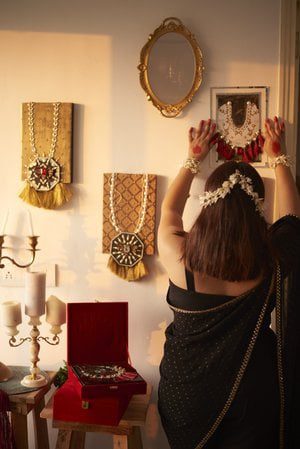
Arts to Hearts Podcast is a show delving into the lives and passions of renowned artists. From running creative businesses and studio art practices to cultivating a successful mindset, Charuka Arora engages in heartfelt conversations with her guests. Experience your personal happy hour with your favorite artists, right in your studio.
Through candid discussions, Charuka and her guests reveal the joys and challenges of a vibrant creative life, both within and beyond our studios. Get ready to be inspired and uplifted as you tune in.
Eileen Halll:

Eileen, is an Ecuadorian and Scottish artist,she immerses herself in a dreamy and meditative world of colors. Inspired by nature and her deep connection to water, Eileen’s work exudes a sense of tranquility and introspection. She opts for watercolors, a medium that allows her to play with fluidity and light, mirroring the shifting nature of consciousness. Through her delicate use of colors, Eileen captures the essence of dreams and the intricate nuances of the subconscious mind.
Kat Vandal:

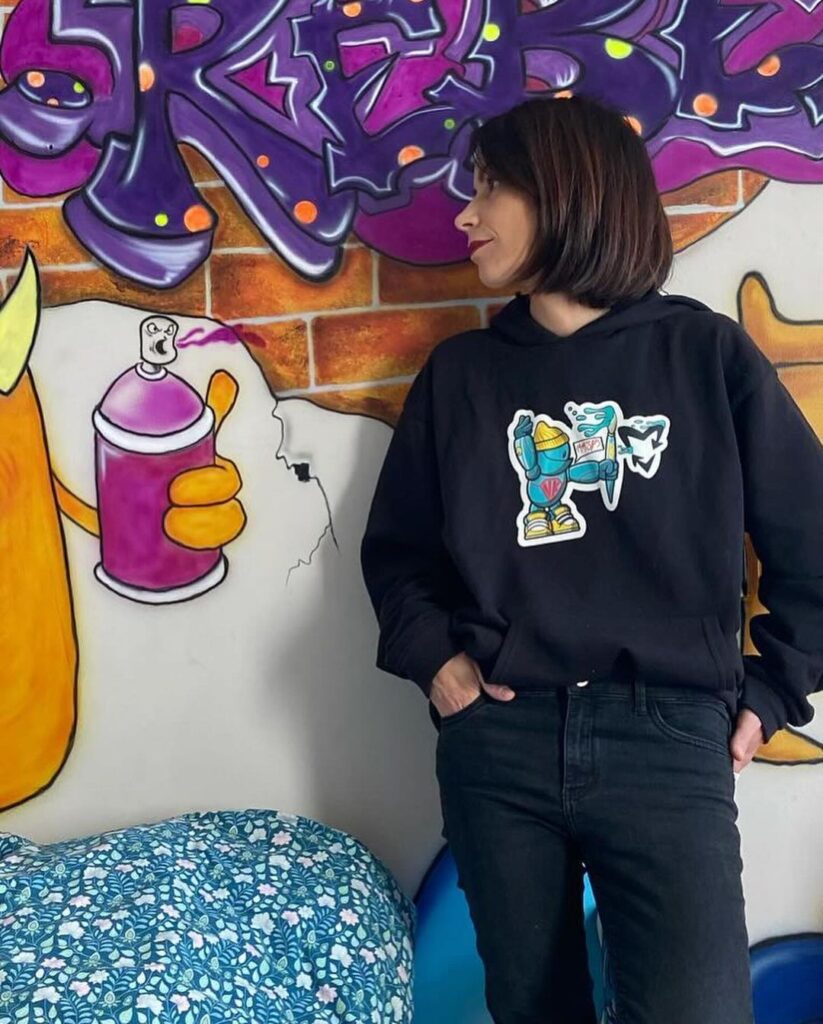
In this episode of our podcast, Charuka Arora sits down with two inspiring artists, Kat Vandal and Eileen Hall. Together, they explore the profound connections between childhood creativity, the emotional impact of colors, and how these elements shape their art. This conversation is filled with personal stories, practical advice, and insightful tips for artists at any stage of their creative journey.
Tapping into Childhood Creativity
Kat Vandal and Eileen Hall both emphasize the importance of rekindling the creativity they experienced as children. “When I paint, I try to approach it with the same sense of wonder and playfulness that I had as a child,” says Kat Vandal. Eileen Hall agrees, adding,
“Our childhood selves weren’t afraid to experiment and make mistakes. Embracing that mindset can open up so many new possibilities in our art.”
The artists share how reconnecting with their inner child has brought new life to their work. They encourage listeners to let go of perfectionism and allow themselves to play and explore. “Art should be fun,” says Eileen. “When we let go of our fears and just enjoy the process, we often create our best work.”
Kat and Eileen delve into specific techniques they use to tap into their childhood creativity. For example, Kat often revisits old sketchbooks and drawings from her childhood. “Seeing those old drawings reminded me of the pure joy of creating,” she says. “It helped me break through my creative block.”
Eileen, on the other hand, engages in playful exercises like finger painting or using unconventional tools to create art. “Sometimes, using something as simple as a stick or a sponge can bring out the childlike wonder in my work,” she explains.
“It’s all about breaking free from conventional methods and rediscovering the joy of creation.”
The Power of Colors in Art
Another key topic of discussion is the emotional impact of colors. Kat and Eileen dive into how different colors can evoke various emotions and how they use this knowledge in their artwork.
“Colors are like a language,” explains Kat. “They can express feelings that words sometimes can’t.”
Eileen shares her insights on color theory and the psychological effects of different hues. “Blue can be calming, while red can evoke passion or anger,” she explains. “Understanding these associations can help artists create more powerful and emotional pieces.”
The artists discuss how they select their color palettes. Kat mentions that she often chooses colors based on her mood or the message she wants to convey. “If I’m feeling peaceful, I might use a lot of blues and greens. But if I want to express something intense, I might go for bold reds and oranges,” she says.
Eileen talks about the importance of experimenting with colors to find what works best. “Don’t be afraid to mix colors and see what happens,” she advises. “Sometimes the most unexpected combinations can lead to the most beautiful results.”
Practical Tips for Artists
Throughout the episode, Kat and Eileen offer practical tips for artists looking to deepen their connection with their inner child and harness the emotional power of colors. They suggest starting with simple exercises, such as creating without a specific goal in mind or experimenting with new color palettes.
“Don’t be afraid to make mistakes,” advises Kat. “Some of the most exciting discoveries in art come from happy accidents.” Eileen adds, “Keep a playful spirit. Art is about expression and exploration, not just about the final product.”
Kat recommends setting aside time for regular creative play. “Dedicate a few hours each week to just have fun with your art,” she suggests. “Use this time to try new techniques, play with colors, and let your imagination run wild.”
Eileen emphasizes the importance of surrounding yourself with inspiration. “Keep a collection of things that inspire you—photos, fabric swatches, anything that catches your eye,” she says. “Having these items nearby can spark new ideas and keep your creativity flowing.”
Personal Stories and Insights
Kat and Eileen share personal stories that highlight the transformative power of embracing childhood creativity and color. Kat recalls a time when she
felt stuck in her work and decided to revisit her childhood sketches for inspiration. “Seeing those old drawings reminded me of the pure joy of creating,” she says. “It helped me break through my creative block.”
Eileen reflects on how a bold use of color changed her approach to painting. “I used to be afraid of using bright colors,” she admits. “But once I started experimenting, I realized how much emotion and energy they could bring to my work.”
Kat shares a memorable project where she completely let go of her inhibitions. “I decided to create a mural using only my hands and bright, bold colors,” she says. “It was messy and chaotic, but it was also incredibly freeing. That project reminded me why I love creating art in the first place.”

Eileen recounts a similar experience with a piece that required her to step out of her comfort zone. “I was working on a series of paintings and felt they were missing something,” she explains. “On a whim, I added splashes of vibrant red and yellow, which completely transformed the pieces. It taught me to trust my instincts and not be afraid to take risks with color.”
The Importance of Emotional Expression in Art
Kat and Eileen also touch on the therapeutic aspects of art.
“Art has always been a way for me to process my emotions,” says Kat. “Whether I’m feeling joy, sadness, or frustration, putting those feelings into my work helps me understand and cope with them.”
Eileen agrees, noting that art can be a powerful tool for healing. “Creating art allows us to express emotions that we might not be able to put into words,” she says. “It’s a way to release what’s inside and make sense of our experiences.”
They both stress the importance of being honest and authentic in their work. “Don’t try to create something perfect,” advises Kat. “Create something real. Your true emotions and experiences are what make your art unique and powerful.”
How to Reconnect with Your Inner Child
The artists offer several strategies for reconnecting with the uninhibited creativity of childhood. Kat suggests revisiting activities you enjoyed as a child, such as drawing, painting, or playing with clay. “Think about what made you happy when you were a kid and try to incorporate those elements into your art,” she says.
Eileen recommends setting aside time for unstructured play. “Give yourself permission to create without a plan or a goal,” she advises. “Let your imagination run wild and see where it takes you.”
Both artists emphasize the importance of creating a safe space where you can experiment and take risks without fear of judgment. “Find a supportive community of fellow artists who encourage and inspire you,” suggests Kat. “Having people who believe in you can make a huge difference.”
Embracing the Power of Colors
Kat and Eileen also discuss the practical aspects of using color in art. They offer tips on selecting color palettes, understanding color theory, and experimenting with different hues and combinations.
“Start by choosing a few colors that resonate with you and see how they interact,” advises Kat. “Don’t be afraid to mix colors and try new things. Sometimes the most unexpected combinations can lead to the most beautiful results.”
Eileen emphasizes the importance of understanding the emotional impact of colors. “Think about the feelings you want to evoke in your work and choose colors that help convey those emotions,” she says. “For example, if you want to create a sense of calm, you might use soft blues and greens. If you want to convey energy and excitement, you might choose bold reds and yellows.”
In the end,
This episode with Kat Vandal and Eileen Hall is a treasure trove of inspiration for artists. By rediscovering the playful creativity of childhood and understanding the emotional power of colors, artists can unlock new dimensions in their work. Charuka Arora’s engaging conversation with these talented artists offers valuable insights and practical advice that can inspire artists to explore and experiment with their art in new and exciting ways.
Tune in to learn how embracing your inner child and harnessing the emotional power of colors can transform your artistic journey.
Listen to this & other episodes on




